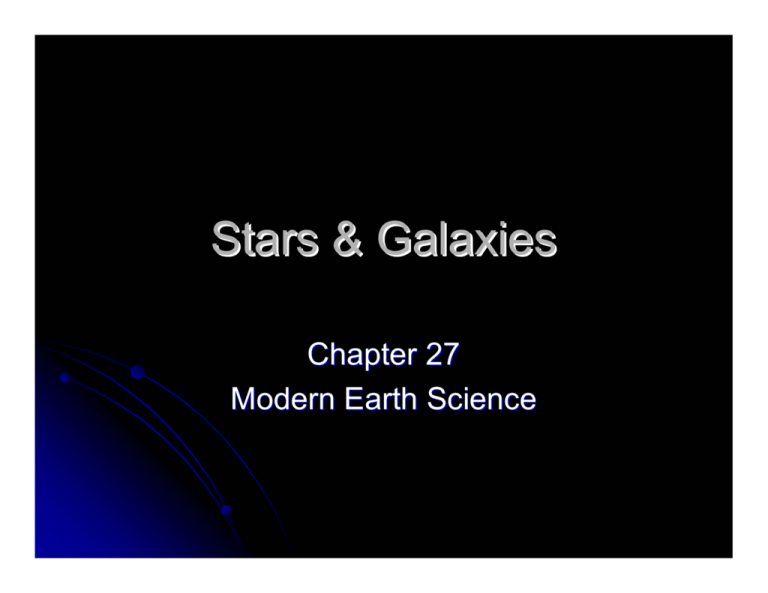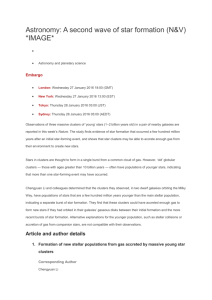PowerPoint
advertisement

Stars & Galaxies Chapter 27 Modern Earth Science Chapter 27, Section 1 27.1 Characteristics of Stars How do astronomers determine the composition and surface temperature of a star? Composition & Temperature Scientists use the following tools to study stars Hydrogen most common element in stars Telescope Observation Spectral Analysis Helium 2nd most common Carbon, oxygen, nitrogen and calcium make up rest of stars Surface Temperature indicated by color Blue – 35,000 Degrees Celsius Red – 3,000 Degrees Celsius OUR SUN – 6,000 Degrees Celsius Types & Temps Spectrum Analysis Astronomers use a spectrometer to analyze the light emitted by stars. Spectrometers separate light into different colors, or wavelengths The wavelengths of light emitted by a star tell astronomers what elements the star is made from. Why do stars appear to move to an observer on the Earth? Motion The apparent motion of stars is the motion visible to the unaided eye. Apparent motion is caused by the movement of Earth. Most stars have several types of actual motion. Stars can rotate on an axis Stars can revolve around another star Stars can move toward and away from Earth Star REVOLVING around another Star moving TOWARD & AWAY from Earth Star ROTATING on axis The Doppler Effect Red Shift – As a star moves away the Earth, the light it emits appears to become red Most distant galaxies, or large groups of stars , have red shifted spectra, indicating that these galaxies are moving away from the Earth Star moving TOWARD Earth BLUE SHIFT Star moving AWAY from Earth RED SHIFT Universal Expansion Blue-shift & red-shift How do astronomers measure the distance from the Earth to the stars? Distance to the Stars Distances in space are measured in lightyears. Light year (ly)= the distance light travels in one Earth year. Speed of light = 300,000 km/sec 1 ly = 9,500,000,000 km (1 ly = 9.5 trillion kilometers) Light Years Parallax -- The change in position of a nearby star compared with the position of a faraway star is called parallax. Apparent Location of Star in July Earth In January EARTH SUN EARTH Earth In July Actual Location of Star Apparent Location of Star in January http://instruct1.cit.cornell.edu/courses/astro101/java/parallax/parallax.html#example What is the difference between absolute magnitude and apparent magnitude? Stellar Magnitudes Astronomers use two scales to determine the brightness of a star Scale #1: How bright does a star appear to be on Earth Scale #2: How bright would a star be if lined up next to all other stars Apparent Magnitude Absolute Magnitude The brightest stars have apparent magnitudes that are negative numbers http://skyserver.fnal.gov/en/proj/advanced/hr/intro.asp Actual & Apparent Magnitude Apparent Magnitude Classification of Stars The Hertzsprung-Russell Diagram shows the relationship between the surface temperatures and the absolute magnitudes (luminosity) of stars (also called the H-R diagram) See page 554. H-R diagram Another version of H-R diagram Supergiants Giants Main Sequence Stars White Dwarfs Study Questions How do astronomers determine the composition and surface temperature of a star? Why do stars appear to move to an observer on the Earth? How do astronomers measure the distance from the Earth to the stars? What is the difference between absolute magnitude and apparent magnitude? 27.2 Stellar Evolution 1. How does a protostar develop into a star? 1st step - Nebula nebula a large cloud of gas and dust in interstellar space; a region in space where stars are born. When the nebula is compressed, some of the particles move close to each other and are pulled together by gravity. 2nd step - Protostar As gravity makes dense regions within a nebula more compact (smaller and more dense), these regions spin and shrink and begin to form a flattened disk. The disk has a central concentration of matter called a protostar. The Birth of a Star A protostar’s temperature continually increases until it reaches about 10,000,000°C. At this temperature, nuclear fusion begins. Nuclear fusion starts by combining hydrogen to form helium. The process releases enormous amounts of energy. The start of nuclear fusion marks the birth of a star. Once this process begins, it can continue for billions of years. 2. How does a main-sequence star generate energy? Main-Sequence Stage The second and longest stage in the life of a star is the main-sequence stage. During this stage, energy continues to be generated in the core of the star as hydrogen fuses into helium. Scientists estimate that over a period of almost 5 billion years, the sun has converted only 5% of its original hydrogen nuclei into helium nuclei. A Delicate Balancing Act As gravity increases the pressure on the matter within the star, the rate of fusion increases. Energy radiated from fusion heats the gas inside the star. The outward pressures of the radiation and the hot gas resist the inward pull of gravity. This equilibrium makes the star stable in size. 3. What can happen to a star during and after the giant stage? Giants & Supergiants giant a very large and bright star whose hot core has used most of its hydrogen enters its third stage (called the giant stage). Loss of hydrogen = less fusion = less energy = cooler temperature of the star. As the gases in the outer shell become cooler, they begin to glow with a reddish color. Normal-sized stars become giants (our Sun). Massive stars become supergiants (Rigel). After the Giant Stage… Planetary nebulas (normal-size stars) White dwarf (normal) Novas (white dwarf) Supernovas (massive stars) Neutron stars (massive stars) Black holes (really massive stars) MUST be able to explain ONE of these… Planetary Nebulas As the star’s outer gases drift away, the remaining core heats these expanding gases. The gases appear as a planetary nebula, a cloud of gas that forms around a sunlike star that is dying. White Dwarf Stars As a planetary nebula disperses, gravity causes the remaining matter in the star to collapse inward. The matter collapses until it cannot be pressed further together. A hot, extremely dense core of matter is left. White dwarfs shine for billions of years before they cool completely. Novas & Supernovas Novas are periodic explosions on white dwarfs that DO NOT destroy the star. Supernovas happen when a star has such a tremendous explosion that it blows itself apart. The explosions of supernovas completely destroy the white dwarf star and may destroy much of the red giant. Neutron Stars neutron star a star that has collapsed under gravity to the point that the electrons and protons have smashed together to form neutrons Stars more massive than the sun do not become white dwarfs. After a star explodes as a supernova, the core may contract into a neutron star. Black Holes black hole an object so massive and dense that even light cannot escape its gravity Some massive stars produce leftovers too massive to become a stable neutron star. These stars contract, and the force of the contraction leaves a black hole. 27.3 Star Groups Dividing Up the Sky constellation a group of stars organized in a recognizable pattern In 1930, astronomers around the world agreed upon a standard set of 88 constellations. Naming Constellations Many of the modern names we use for the constellations come from Latin. Some constellations are named for real or imaginary animals, such as Ursa Major (the great bear) or ancient gods or legendary heroes, such as Hercules or Orion. The Constellation Orion Multiple-Star Systems Over half of all observed stars form multiple-star systems. Binary stars are pairs of stars that revolve around each other and are held together by gravity. The center of mass, or barycenter, is somewhere between the two stars. In star systems that have more than two stars, two stars may revolve rapidly around a common barycenter, while a third star revolves more slowly at a greater distance from the pair. Star Clusters Sometimes, nebulas collapse to form groups of hundreds or thousands of stars called clusters. Globular clusters have a spherical shape and can contain up to 100,000 stars. An open cluster is loosely shaped and rarely contains more than a few hundred stars. Galaxies galaxy a collection of stars, dust, and gas bound together by gravity Galaxies are the major building blocks of the universe. Astronomers estimate that the universe contains hundreds of billions of galaxies. A typical galaxy, such as the Milky Way, has a diameter of bout 100,000 light-years and may contain more than 200 billion stars. Distances to Galaxies Giant stars called Cepheid variables brighten and fade in a regular pattern. Most Cepheids have regular cycles. The longer the cycle, the brighter the star’s absolute magnitude. Scientists compare the Cepheid’s absolute magnitude and the Cepheid’s apparent magnitude to calculate the distance to the Cepheid variable. This distance tells scientists the distance to the galaxy in which the Cepheid is located. Types of Galaxies Galaxies are classified by shape into three main types. A spiral galaxy has a nucleus of bright stars and flattened arms that spiral around the nucleus. Elliptical galaxies have various shapes and are extremely bright in the center and do not have spiral arms. An irregular galaxy has no particular shape, and is fairly rich in dust and gas. The Milky Way The galaxy in which we live, the Milky Way, is a spiral galaxy in which the sun is one of hundreds of billions of stars. Two irregular galaxies, the Large Magellanic Cloud and Small Magellanic Cloud, are our closest neighbors. These three galaxies are called the Local Group. Quasars quasar quasi-stellar radio source; a very luminous object that produces energy at a high rate. Quasars appear as points of light, similar to stars. Quasars are located in the centers of galaxies that are distant from Earth. Quasars are among the most distant objects that have been observed from Earth. The Big Bang Theory Universal Expansion









